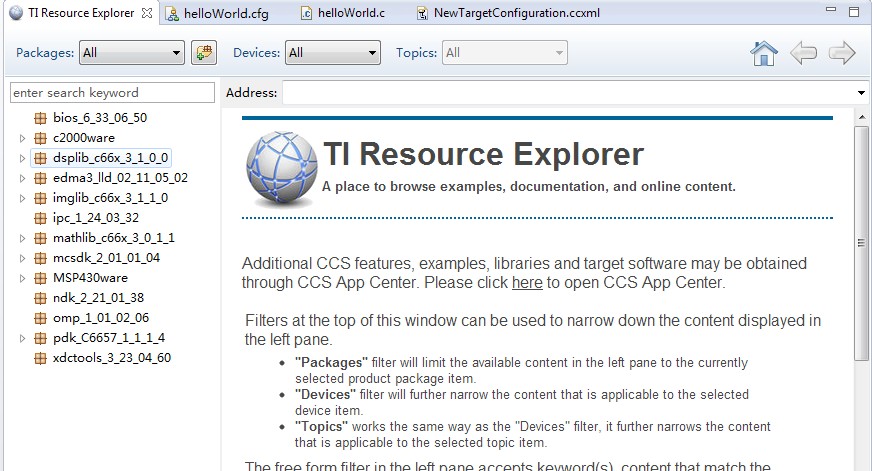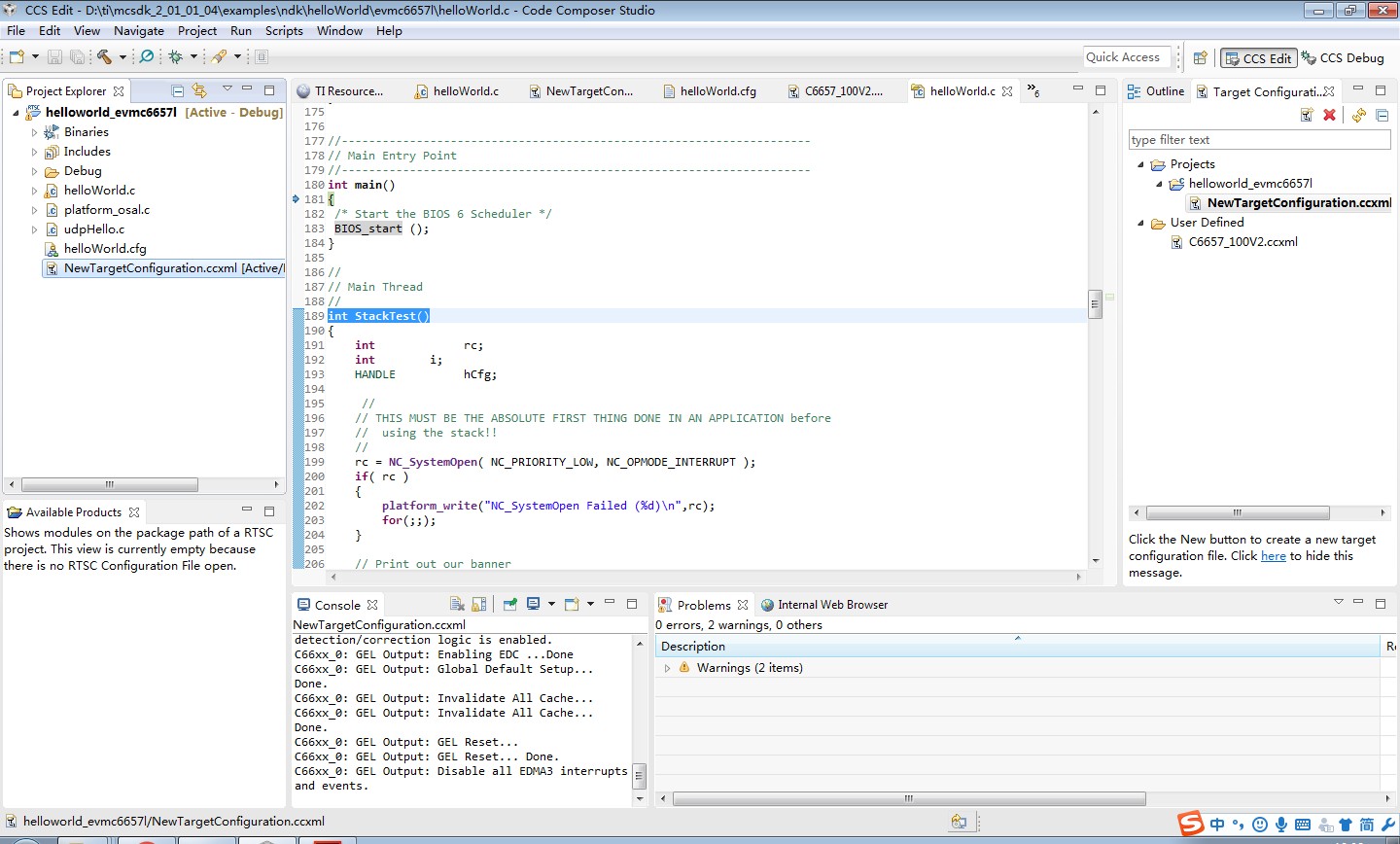dsp6657的helloworld例程测试-第一篇
环境搭建可以参考http://blog.sina.com.cn/s/blog_ed2e19900102xi2j.html
1. 先从mcsdk导入工程,helloworld例程

2. 提示有错误,估计是库找不到的原因。

3. 打开CCS的配置页面,add加入需要的库,分别是NDK,PDK,其中NDK就是网络Network Developer's Kit开发包,如果CCS添加NDK失败的话,可能是NDK的版本太旧了,去下载个新的,下载地址:http://software-dl.ti.com/dsps/dsps_public_sw/sdo_sb/targetcontent/ndk/index.html,自己选个版本即可

4. 看下工程源码,其实想找个简单的入门例程研究,可惜找了个网络TCP/IP协议栈的,研究研究吧
/*
* helloWorld_bios6.c
* TCP/IP Stack 'Hello World!' Example ported to use BIOS6 OS.
*/ //--------------------------------------------------------------------------
// IP Stack 'Hello World!' Example
// To test it as is, use with helloWorld.exe from \winapps directory
// #include <stdio.h>
#include <ti/ndk/inc/netmain.h> /* BIOS6 include */
#include <ti/sysbios/BIOS.h> /* Platform utilities include */
#include "ti/platform/platform.h"
#include "ti/platform/resource_mgr.h" /* Platform Information - we will read it form the Platform Library */
platform_info gPlatformInfo; //---------------------------------------------------------------------------
// Title String
//
char *VerStr = "\nTCP/IP Stack 'Hello World!' Application\n\n"; // Our NETCTRL callback functions
static void NetworkOpen();
static void NetworkClose();
static void NetworkIPAddr( IPN IPAddr, uint IfIdx, uint fAdd ); // Fun reporting function
static void ServiceReport( uint Item, uint Status, uint Report, HANDLE hCfgEntry ); // External references
extern int dtask_udp_hello(); //---------------------------------------------------------------------------
// Configuration
//
char *HostName = "tidsp";
char *LocalIPAddr = "192.168.2.100";
char *LocalIPMask = "255.255.255.0"; // Not used when using DHCP
char *GatewayIP = "192.168.2.101"; // Not used when using DHCP
char *DomainName = "demo.net"; // Not used when using DHCP
char *DNSServer = "0.0.0.0"; // Used when set to anything but zero /*************************************************************************
* @b EVM_init()
*
* @n
*
* Initializes the platform hardware. This routine is configured to start in
* the evm.cfg configuration file. It is the first routine that BIOS
* calls and is executed before Main is called. If you are debugging within
* CCS the default option in your target configuration file may be to execute
* all code up until Main as the image loads. To debug this you should disable
* that option.
*
* @param[in] None
*
* @retval
* None
************************************************************************/
void EVM_init()
{
int i;
platform_init_flags sFlags;
platform_init_config sConfig;
/* Status of the call to initialize the platform */
Int32 pform_status;
/* Platform Information - we will read it form the Platform Library */
platform_info sPlatformInfo; /*
* You can choose what to initialize on the platform by setting the following
* flags. We will initialize everything.
*/
memset( (void *) &sFlags, , sizeof(platform_init_flags));
memset( (void *) &sConfig, , sizeof(platform_init_config)); sFlags.pll = ;
sFlags.ddr = ;
sFlags.tcsl = ; /* Time stamp counter */
sFlags.phy = ; /* Ethernet */
sFlags.ecc = ; sConfig.pllm = ; pform_status = platform_init(&sFlags, &sConfig); /* If we initialized the platform okay */
if (pform_status == Platform_EOK) {
/* Get information about the platform so we can use it in various places */
memset( (void *) &sPlatformInfo, , sizeof(platform_info));
(void) platform_get_info(&sPlatformInfo);
}
else {
/* Intiialization of the platform failed... die */
printf("Platform failed to initialize. Error code %d \n", pform_status);
printf("We will die in an infinite loop... \n");
while () {
(void) platform_led(, PLATFORM_LED_ON, (LED_CLASS_E) PLATFORM_USER_LED_CLASS);
(void) platform_delay();
(void) platform_led(, PLATFORM_LED_OFF, (LED_CLASS_E) PLATFORM_USER_LED_CLASS);
(void) platform_delay();
};
} platform_write_configure(PLATFORM_WRITE_PRINTF);
platform_uart_init();
platform_uart_set_baudrate(); /* Check to see that we are running on the Master Core */
if (platform_get_coreid() != ) {
/* We are not on the Master Core... die */
printf("You must run this application on Core 0. \n");
printf("We will die in an infinite loop... \n");
while () {
(void) platform_led(, PLATFORM_LED_ON, (LED_CLASS_E) PLATFORM_USER_LED_CLASS);
(void) platform_delay();
(void) platform_led(, PLATFORM_LED_OFF, (LED_CLASS_E) PLATFORM_USER_LED_CLASS);
(void) platform_delay();
};
} /* Clear the state of the LEDs to OFF */
for (i=; i < sPlatformInfo.led[].count; i++) {
platform_led(i, PLATFORM_LED_OFF, (LED_CLASS_E) PLATFORM_USER_LED_CLASS);
} return;
} //---------------------------------------------------------------------
// Main Entry Point
//---------------------------------------------------------------------
int main()
{
/* Start the BIOS 6 Scheduler */
BIOS_start ();
} //
// Main Thread
//
int StackTest()
{
int rc;
int i;
HANDLE hCfg; //
// THIS MUST BE THE ABSOLUTE FIRST THING DONE IN AN APPLICATION before
// using the stack!!
//
rc = NC_SystemOpen( NC_PRIORITY_LOW, NC_OPMODE_INTERRUPT );
if( rc )
{
platform_write("NC_SystemOpen Failed (%d)\n",rc);
for(;;);
} // Print out our banner
platform_write(VerStr); //
// Create and build the system configuration from scratch.
// // Create a new configuration
hCfg = CfgNew();
if( !hCfg )
{
platform_write("Unable to create configuration\n");
goto main_exit;
} // We better validate the length of the supplied names
if( strlen( DomainName ) >= CFG_DOMAIN_MAX ||
strlen( HostName ) >= CFG_HOSTNAME_MAX )
{
printf("Names too long\n");
goto main_exit;
} // Add our global hostname to hCfg (to be claimed in all connected domains)
CfgAddEntry( hCfg, CFGTAG_SYSINFO, CFGITEM_DHCP_HOSTNAME, ,
strlen(HostName), (UINT8 *)HostName, ); // If the IP address is specified, manually configure IP and Gateway
if (!platform_get_switch_state())
{
CI_IPNET NA;
CI_ROUTE RT;
IPN IPTmp; // Setup manual IP address
bzero( &NA, sizeof(NA) );
NA.IPAddr = inet_addr(LocalIPAddr);
NA.IPMask = inet_addr(LocalIPMask);
strcpy( NA.Domain, DomainName );
NA.NetType = ; // Add the address to interface 1
CfgAddEntry( hCfg, CFGTAG_IPNET, , ,
sizeof(CI_IPNET), (UINT8 *)&NA, ); // Add the default gateway. Since it is the default, the
// destination address and mask are both zero (we go ahead
// and show the assignment for clarity).
bzero( &RT, sizeof(RT) );
RT.IPDestAddr = ;
RT.IPDestMask = ;
RT.IPGateAddr = inet_addr(GatewayIP); // Add the route
CfgAddEntry( hCfg, CFGTAG_ROUTE, , ,
sizeof(CI_ROUTE), (UINT8 *)&RT, ); // Manually add the DNS server when specified
IPTmp = inet_addr(DNSServer);
if( IPTmp )
CfgAddEntry( hCfg, CFGTAG_SYSINFO, CFGITEM_DHCP_DOMAINNAMESERVER,
, sizeof(IPTmp), (UINT8 *)&IPTmp, );
}
// Else we specify DHCP
else
{
CI_SERVICE_DHCPC dhcpc; // Specify DHCP Service on IF-1
bzero( &dhcpc, sizeof(dhcpc) );
dhcpc.cisargs.Mode = CIS_FLG_IFIDXVALID;
dhcpc.cisargs.IfIdx = ;
dhcpc.cisargs.pCbSrv = &ServiceReport;
CfgAddEntry( hCfg, CFGTAG_SERVICE, CFGITEM_SERVICE_DHCPCLIENT, ,
sizeof(dhcpc), (UINT8 *)&dhcpc, );
} //
// Configure IPStack/OS Options
// // We don't want to see debug messages less than WARNINGS
rc = DBG_WARN;
CfgAddEntry( hCfg, CFGTAG_OS, CFGITEM_OS_DBGPRINTLEVEL,
CFG_ADDMODE_UNIQUE, sizeof(uint), (UINT8 *)&rc, ); //
// This code sets up the TCP and UDP buffer sizes
// (Note 8192 is actually the default. This code is here to
// illustrate how the buffer and limit sizes are configured.)
// // UDP Receive limit
rc = ;
CfgAddEntry( hCfg, CFGTAG_IP, CFGITEM_IP_SOCKUDPRXLIMIT,
CFG_ADDMODE_UNIQUE, sizeof(uint), (UINT8 *)&rc, ); //
// Boot the system using this configuration
//
// We keep booting until the function returns 0. This allows
// us to have a "reboot" command.
//
do
{
rc = NC_NetStart( hCfg, NetworkOpen, NetworkClose, NetworkIPAddr );
} while( rc > ); // Delete Configuration
CfgFree( hCfg ); // Close the OS
main_exit:
NC_SystemClose();
return();
} //
// System Task Code [ Server Daemon Servers ]
//
static HANDLE hHello=; //
// NetworkOpen
//
// This function is called after the configuration has booted
//
static void NetworkOpen()
{
// Create our local server
hHello = DaemonNew( SOCK_DGRAM, , , dtask_udp_hello,
OS_TASKPRINORM, OS_TASKSTKNORM, , );
} //
// NetworkClose
//
// This function is called when the network is shutting down,
// or when it no longer has any IP addresses assigned to it.
//
static void NetworkClose()
{
DaemonFree( hHello );
} //
// NetworkIPAddr
//
// This function is called whenever an IP address binding is
// added or removed from the system.
//
static void NetworkIPAddr( IPN IPAddr, uint IfIdx, uint fAdd )
{
IPN IPTmp; if( fAdd )
printf("Network Added: ");
else
printf("Network Removed: "); // Print a message
IPTmp = ntohl( IPAddr );
printf("If-%d:%d.%d.%d.%d\n", IfIdx,
(UINT8)(IPTmp>>)&0xFF, (UINT8)(IPTmp>>)&0xFF,
(UINT8)(IPTmp>>)&0xFF, (UINT8)IPTmp&0xFF );
} //
// Service Status Reports
//
// Here's a quick example of using service status updates
//
static char *TaskName[] = { "Telnet","HTTP","NAT","DHCPS","DHCPC","DNS" };
static char *ReportStr[] = { "","Running","Updated","Complete","Fault" };
static char *StatusStr[] = { "Disabled","Waiting","IPTerm","Failed","Enabled" };
static void ServiceReport( uint Item, uint Status, uint Report, HANDLE h )
{
printf( "Service Status: %-9s: %-9s: %-9s: %03d\n",
TaskName[Item-], StatusStr[Status],
ReportStr[Report/], Report&0xFF ); //
// Example of adding to the DHCP configuration space
//
// When using the DHCP client, the client has full control over access
// to the first 256 entries in the CFGTAG_SYSINFO space.
//
// Note that the DHCP client will erase all CFGTAG_SYSINFO tags except
// CFGITEM_DHCP_HOSTNAME. If the application needs to keep manual
// entries in the DHCP tag range, then the code to maintain them should
// be placed here.
//
// Here, we want to manually add a DNS server to the configuration, but
// we can only do it once DHCP has finished its programming.
//
if( Item == CFGITEM_SERVICE_DHCPCLIENT &&
Status == CIS_SRV_STATUS_ENABLED &&
(Report == (NETTOOLS_STAT_RUNNING|DHCPCODE_IPADD) ||
Report == (NETTOOLS_STAT_RUNNING|DHCPCODE_IPRENEW)) )
{
IPN IPTmp; // Manually add the DNS server when specified
IPTmp = inet_addr(DNSServer);
if( IPTmp )
CfgAddEntry( , CFGTAG_SYSINFO, CFGITEM_DHCP_DOMAINNAMESERVER,
, sizeof(IPTmp), (UINT8 *)&IPTmp, );
}
}
5. 刚开始这些代码看的不是很明白。main函数里面为啥只有一个BIOS_start();函数?不是应该创建任务之类的?
int main()
{
/* Start the BIOS 6 Scheduler */
BIOS_start ();
}
6. 下面函数怎么运行的?
int StackTest()
7. 是不是BIOS的图形配置界面搞定的?去看下图形配置界面。图形配置界面应该有个.tcf文件,但是工程没找到?

8. 下面的是使用协议栈必须首先调用的函数
rc = NC_SystemOpen( NC_PRIORITY_LOW, NC_OPMODE_INTERRUPT );
9. 接着是配置网络参数的函数
CfgAddEntry( hCfg, CFGTAG_SYSINFO, CFGITEM_DHCP_HOSTNAME, ,
strlen(HostName), (UINT8 *)HostName, );
10. 这次疑问很多,RTSC是德州仪器提出的嵌入式组件,我理解就是把代码模块化,这个模块化的工作交给CCS去管理,比如需要一个ADC模块,在CCS里面配置就可以,CCS会把代码加入你的工程,XDCTools 是完成上面的工具,RTSC是一种理念。
dsp6657的helloworld例程测试-第一篇的更多相关文章
- dsp6657的helloworld例程测试-第二篇-CFG文件
1. 上一篇疑问,int StackTest()这个函数是怎么运行的,后来在.cfg文件找到了答案,.cfg包含丰富的信息,对于用惯C语言的,确实不太习惯 var Memory = xdc.useMo ...
- 创龙DSP6748开发板上电测试-第一篇
1. 创龙DSP6748开发板测试.2980元的售价很高,我估计新的1200元比较合适,当然创龙定价是按照供需关系的.仿真器XDS100V2卖598元,真是狮子大张口. 2. 上电是5V-2A的电源. ...
- 天嵌IMX6开发板测试-第一篇
1.看下开发板介绍 品牌: 天嵌 CPU型号: NXP i.MX6Q 架构: Cortex_A9 主频: *1GHz 内存: 2GB DDR3 存储: 8GB eMMC FLA(64GB可扩) 2. ...
- 使用cnblogs发布第一篇文章,HelloWorld
HelloWorld! 瞅瞅源码的样式,嗯,语法高亮还是可以的,辨识度还是挺高的. <!DOCTYPE html> <html> <head> <meta c ...
- LARK BOARD开发板试用第一篇-上电测试学习
1. 先看下板子外观,做工很不错 2. 主芯片的型号是,SoC 为 Cyclone V SX 系列的 5CSXFC6D6F31,不仅在芯片中包含传统的 FPGA 架构,还集成了基于 ARM Corte ...
- go [第一篇]初识
[第一篇] 简介 Go 是一个开源的编程语言,它能让构造简单.可靠且高效的软件变得容易. Go是从2007年末由Robert Griesemer, Rob Pike, Ken Thompson主持开发 ...
- 第一篇 入门必备 (Android学习笔记)
第一篇 入门必备 第1章 初识Android 第2章 搭建你的开发环境 第3章 创建第一个程序--HelloWorld 第4章 使用Android工具 ●Android之父 Android安迪·罗 ...
- 深入学习jQuery选择器系列第一篇——基础选择器和层级选择器
× 目录 [1]id选择器 [2]元素选择器 [3]类选择器[4]通配选择器[5]群组选择器[6]后代选择器[7]兄弟选择器 前面的话 选择器是jQuery的根基,在jQuery中,对事件处理.遍历D ...
- 前端工程师技能之photoshop巧用系列第一篇——准备篇
× 目录 [1]作用 [2]初始化 [3]常用工具[4]快捷键 前面的话 photoshop是前端工程师无法回避的一个软件,这个软件本身很强大,但我们仅仅需要通过这个工具来完成基本的切图工作即可.本文 ...
随机推荐
- 浅谈MVP架构及开发模式
Model-View-Presenter(MVP)概述 MVC模式已经出现了几十年了,在GUI领域已经得到了广泛的应用,由于微软ASP.NET MVC Framework的出现,致使MVC一度成 ...
- rinted端口转发工具
下载包: [root@localhost opt]# wget https://boutell.com/rinetd/http/rinetd.tar.gz 解压编译安装: [root@localhos ...
- 获取 当前显示的 UIViewController
UIViewController * findBestVC(UIViewController *vc) { if (vc.presentedViewController) { return findB ...
- ubuntu配置telnet服务
1.安装xinetd 以及telnetd #:~$ sudo apt-get install xinetd telnetd 2.配置文件(若文件不存在就手动添加文件和相应配置信息) 1): #:~$ ...
- IIS中ASP.NET虚拟目录不继承主站点web.config设置的办法(转载)
ASP.NET提供了强大的Web.config来配置网站,一般来说一个网站只有一个根目录下的Web.config文件,有时候我们希望子目录有着不同的权限或者参数设置,则可以在相应子目录增加一个Web. ...
- volatile、static
谈到 volatile.static 就必须说多线程. 1.一个线程在开始执行的时候,会开启一片自己的工作内存(自己线程私有),同时将主内存中的数据复制到自己 的工作内存,从此读写数据都是自己的工作内 ...
- JBDC—③数据库连接池的介绍、使用和配置
首先要知道数据库连接(Connection对象)的创建和关闭是非常浪费系统资源的,如果是使用常规的数据库连接方式来操作数据库,当用户变多时,每次访问数据库都要创建大量的Connnection对象,使用 ...
- MongoDB Linux安装
MongoDB 提供了 linux 各发行版本 64 位的安装包,你可以在官网下载安装包. 下载地址:https://www.mongodb.com/download-center#community ...
- Delphi XE7的蓝牙 Bluetooth
Delphi XE7已经内建了蓝牙功能,提供了System.Bluetooth.pas单元 顾名思义,System表示XE7的蓝牙功能可以在Windows,Android,IOS系统内使用 Syste ...
- linux用户及文件管理
帮助命令 whatis 命令 #显示命令的简短功能 man 命令 #查看手册页和命令描述 命令--help #适用于外部命令 help 命令 #适用于内部命令 type 命令 ...
